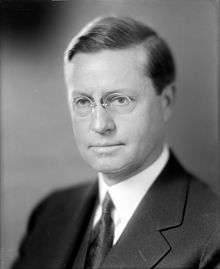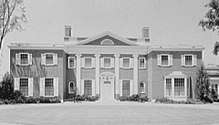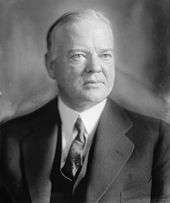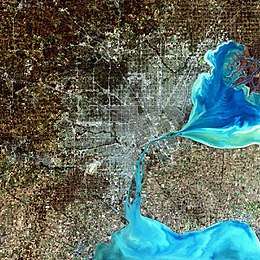Roy D. Chapin
Roy Dikeman Chapin, Sr. (February 23, 1880 – February 16, 1936) was an American industrialist and cofounder of Hudson Motor Company, the predecessor of American Motors. He also served as the United States Secretary of Commerce from August 8, 1932, to March 3, 1933, during the final months of the administration of President Herbert Hoover.
Roy Chapin | |
|---|---|
 | |
| 6th United States Secretary of Commerce | |
| In office August 8, 1932 – March 3, 1933 | |
| President | Herbert Hoover |
| Preceded by | Robert P. Lamont |
| Succeeded by | Daniel C. Roper |
| Personal details | |
| Born | Robert Dikeman Chapin February 23, 1880 Lansing, Michigan, U.S. |
| Died | February 16, 1936 (aged 55) Detroit, Michigan, U.S. |
| Resting place | Woodlawn Cemetery |
| Political party | Republican |
| Spouse(s) | Inez Tiedeman (1914–1936) |
| Children | 6, including Roy |
| Education | University of Michigan, Ann Arbor |
Early life
He was born on February 23, 1880 in Lansing, Michigan, the son of Edward Cornelius Chapin and Ella Rose King. He attended the University of Michigan.
Chapin married the former Inez Tiedeman in 1914. The couple had six children. One son, Roy D. Chapin Jr., would also pursue a career with Hudson Motor Company, eventually leading American Motors Corporation (AMC).
Commercial interests

Chapin headed the consortium of businessmen and engineers that founded the Hudson Motor Car Company in 1908. The company was named for Detroit merchant Joseph L. Hudson, who provided the majority of capital for the operation's start-up.
Chapin was also behind the 1918 formation of the Essex Motors Company, a subsidiary of Hudson. Essex is notable for developing the first affordable mass-produced enclosed automobile in 1922.[1] Because of the success of the inexpensive enclosed Essex Coach line, the American automobile industry shifted away from open touring cars in order to meet consumer demand for all-weather passenger vehicles.
In 1927 he replaced Clifton as the head of the National Automobile Chamber of Commerce.[2]
In addition to his corporate interests, Chapin spearheaded the drive to build the Lincoln Highway, along with Henry B. Joy of Packard Motors. While Chapin viewed a system of professionally designed and built roadways as the greatest way to grow the automobile industry, he also saw the modern roadways movement as a way to secure long range strength for the United States as a nation.
Political activities
_thc.5a39783.jpg)
After building Hudson into one of the most profitable independent American automobile manufacturers, Chapin left Hudson for the Hoover administration upon his appointment in 1932.
During his tenure as Secretary of Commerce, Chapin was unsuccessful in persuading Henry Ford to provide financial help to avoid the collapse of the Union Guardian Trust Company of Detroit. Ford's refusal to aid the bank in averting a financial failure led to the Michigan Bank Holiday, an event that began a series of state bank holidays and ultimately to the passage of Roosevelt administration's Emergency Banking Act of 1933.
Death
Chapin returned to Hudson in March 1933. His final three years were spent trying to save the company from the effects of the Great Depression. He died in Detroit, Michigan on February 16, 1936.[3] He was succeeded at Hudson by A.E. Barit.[4] He is buried in Woodlawn Cemetery.
Legacy

In 1927, Chapin commissioned noted architect John Russell Pope to design a residence for his family at 447 Lake Shore Road in Grosse Pointe Farms, Michigan. Pope later designed the Jefferson Memorial, National Archives Building and National Gallery of Art in Washington, D.C.. Bryant Fleming landscaped the grounds which included 600-year-old yews imported from England. Mrs. Chapin occupied the residence until her death in 1956 when Henry Ford II and wife Anne purchased the property. Ford owned the estate until 1983 when he demolished the house and divided the land to construct condominiums.[5]
In 1954, Nash Kelvinator acquired Hudson in a friendly merger. The resulting company, American Motors Corporation (AMC), continued operation until Chrysler acquired it in 1987. Chapin's son, Roy D. Chapin Jr., served as chairman and chief executive officer of AMC and led the automaker to the acquisition of Kaiser Jeep Corporation in 1970. Chapin was inducted into the Automotive Hall of Fame in 1972.[6][7] His grandson, William R. Chapin, was named president of the Automotive Hall of Fame in 2010.
References
- "1922 Affordable Closed Cars". Popular Mechanics. 173 (5): 50. May 1996. Retrieved September 5, 2017.
- "Motor Men Elect Chapin. Hudson's Head Succeeds Clifton as President of Chamber". The New York Times. March 4, 1927. Retrieved January 22, 2020.
- "Roy D. Chapin Dead. In Hoover Cabinet. Former Secretary of Commerce Was President of Hudson Motor Car Company. Worked For Good Roads. Drove First Car From Detroit to New York. Spent Life in Automotive Field". The New York Times. February 17, 1936. Retrieved January 22, 2020.
- "Barit Head Of Hudson. Succeeds the Late Roy D. Chapin. Factories Plan Production". The New York Times. February 23, 1936.
- "Historical Architecture of Grosse Pointe – 447 Lake Shore". Higbie Maxon Agney. August 5, 2014. Retrieved September 5, 2017.
- "People". Highway Highlights. National Highway Users Conference: 167. 1974. Retrieved March 7, 2016.
- "Roy D. Chapin, Inducted 1972". Hall of Fame Inductees. Automotive Hall of Fame. Retrieved January 22, 2020.
Further reading
- May, George S. The Detroit-New York Odyssey of Roy D. Chapin. Detroit in Perspective 2 (Aug. 1973): 5-25.
- The Bentley Historical Library at the University of Michigan has a collection of Chapin's papers:
- Roy D. Chapin, by J.C. Long (biography)
External links
| Wikimedia Commons has media related to Roy D. Chapin. |
- Works by or about Roy D. Chapin at Internet Archive
- University of Michigan - Bentley History Library
| Business positions | ||
|---|---|---|
| Preceded by One of the founders of the company |
Chairman and CEO of Hudson Motor Car Company 1908–1932 and 1933–1936 |
Succeeded by A. E. Barit |
| Political offices | ||
|---|---|---|
| Preceded by Robert P. Lamont |
U.S. Secretary of Commerce Served under: Herbert Hoover August 8, 1932 – March 3, 1933 |
Succeeded by Daniel C. Roper |


